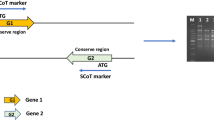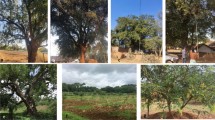Abstract
At present, the available SSR markers of elm (Ulmus) have been seriously deficient, which can not meet the needs of molecular marker-assisted breeding and evaluation of germplasm resources. In this study, transcriptome data of Ulmus pumila were used as materials to develop EST-SSR markers of elms. EST-SSR markers were also classified according to gene function for the first time. In this study, 8288 perfect and 569 compound SSR loci were detected from 17,624 EST sequences (36,609,384 bp). Most of the perfect SSR sequences were based on short sequence lengths of 10–22 bp. The most common SSR repeat units were A/T (3330, 40.18%), AG/CT (1211, 14.61%), and AAG/CTT (568, 6.85%). All EST-SSR loci were function classified based on the Cluster of Orthologous Groups (COG) database. There were substantial differences in the type and proportion of SSR repeat units among the functional classes. Most EST-SSR loci were located in gene-coding regions. Ninety pairs were randomly selected and tested for validation using polymerase chain reaction amplification. Forty-nine primers were verified with clear bands. The number of alleles per locus (Na) ranged from 2 to 6; the number of effective alleles (Ne) ranged from 1.061 to 3.261; the observational heterozygosity (Ho) and expected heterozygosity (He) ranged from 0 to 0.968 and 0.112 to 0.651, respectively. The clustering pattern is consistent with traditional taxonomy that provides a molecular basis for the classification of elm. There were differences in the effective amplification and percentage of polymorphic loci among different functional SSR loci. The analysis of 880 primer combinations showed that markers within a single COG group were less effective than across groups. This study clarified the importance of SSR primer selection for clustering results. This study developed a large number of SSR markers in elm, providing effective markers for molecular marker-assisted breeding, genetic mapping, and other related research.





Similar content being viewed by others
Data archiving statement
Sequencing data were available through BioProject PRJNA349076. Four samples were run on an Illumina Hiseq2500 at Beijing Biomarker Technology, China, on August 2015. The samples were SAMN05915700, SAMN05915701, SAMN05915704, and SAMN05915703 (https://www.ncbi.nlm.nih.gov/bioproject/PRJNA349076).
References
Brouwer JR, Willemsen R, Oostra BA (2009) Microsatellite repeat instability and neurological disease. Bioessays 31(1):71–83. https://doi.org/10.1002/bies.080122
Cheng HZ (2002) Garden plant cultivation and maintenance. Higher Education Press, Beijing
Conde P, Sousa A, Costa A, Santos C (2008) A protocol for Ulmus minor Mill. micropropagation and acclimatization. Plant Cell Tissue Org Cult 92:113–119. https://doi.org/10.1007/s11240-007-9310-8
Dias MC, Monteiro C, Moutinho-Pereira J, Correia C, Gonçalves B, Santos C (2013a) Cadmium toxicity affects photosynthesis and plant growth at different levels. Acta Physiol Plant 35:1281–1289. https://doi.org/10.1007/s11738-012-1167-8
Eujayl I, Sorrells M, Banm M, Wolters P, Powell W (2002) Isolation of EST-derived microsatellite markers for genotyping the A and B genomes of wheat. Theor Appl Genet 104(2):399–407. https://doi.org/10.1007/s001220100738
Eujayl I, Sorrells M, Baum M, Wolters P, Powell W (2001) Assessment of genotypic variation among cultivated durum wheat based on EST-SSRs and genomic SSRs. Euphytica 119(12):39–43. https://doi.org/10.1023/A:1017537720475
Fondon JW III, Hammock EA, Hannan AJ, King DG (2008) Simple sequence repeats: genetic modulators of brain function and behavior. Trends Neurosci 31(7):328–334
Fu LG (1980) Notulae de ulmus sinensibus. J Northeast Forestry Univ 3:1–40
Gao Y, Liu FZ, Cao YF, Wang K (2007) Analysis of genetic relationship for Malusgermplasm resources by SSR markers. J Fruit Sci 24(2):129–134
Gao W, Wang KB, Liu F, Wang CY, Zhang XD, Wang YH, Li SH (2013) Effection of the quantity of SSR primer and allele on cluster analysis of Gossypium hirsutum Linn races. J Plant Geneti Resourc 14(2):237–242
Ge Y, Tan L, Wu B, Wang T, Zhan R (2019) Transcriptome sequencing of different avocado ecotypes: de novo transcriptome assembly, annotation, identification and validation of est-ssr markers. Forests 10(5):411
Guo LN, Zhao XL, Gao XF (2016) De novo assembly and characterization of leaf transcriptome for the development of EST-SSR markers of the non-model species Indigofera szechuensis. Biochem Syst Ecol 68:36–43. https://doi.org/10.1016/j.bse.2016.06.010
Guo SG, Zheng Y, Joung JG, Liu SQ, Zhang ZH, Crasta OR, Sobral BW, Xu Y, Huang S, Fei ZJ (2010) Transcriptome sequencing and comparative analysis of cucumber flowers with different sex types. BMC Genomics 11:384–391. https://doi.org/10.1186/1471-2164-11-384
Grudzinskaya IA (1962) The taxonomic position of Ulmus pinnato-ramosa Dieck. Soobshch Lab Lesovedeniya Akad Nauk Sssr 6:19–27
Han XF, Ling QF, Li CJ, Wang GC, Xu ZC, Lu GQ (2016) Characterization of pikeperch (Sander lucioperca) transcriptome and development of SSR markers. Biochem Syst Ecol 66:188–195. https://doi.org/10.1016/j.bse.2016.04.001
Jia DM (2016) Survey and analysis of simple sequence repeats (SSRs) in three genomes of Candida species. Gene 548(2):129–135. https://doi.org/10.1016/j.gene.2016.02.018
Lalitha S (2000) Primer Premier 5. BioTech Softw Int Rep 1(6):270–272. https://doi.org/10.1089/152791600459894
Li YH, Zhou GY, Ma JX, Jiang WK, Jin LJ, Zhang ZH et al (2014) De novo assembly of soybean wild relatives for pan genome analysis of diversity and agronomic traits. Nat Biotechnol 32(10):1045–1052
Mohammad RB, Mansour E, EsmaeilE (2011) Discovery of EST-SSRS in lung cancer: tagged ESTS with SSRS lead to differential amino acid and protein expression patterns in cancerous tissues. PLoS One 6:e27118. https://doi.org/10.1371/journal.pone.0027118
Morgante M, Hanafey M, Powell W (2002) Microsatellites are preferentially associated with nonrepetitive DNA in plant genomes. Nat Genet 30(2):194–200. https://doi.org/10.1038/ng822
Nicolai M, Pisani C, Bouchet JP, Vuylsteke M, Palloix A (2012) Discovery of a large set of SNP and SSR genetic markers by high-throughput sequencing of pepper (Capsicum annuum). Genet Mol Res 11(3):2295–2300. https://doi.org/10.4238/2012.August.13.3
Pai TW, Chen CM (2016) SSRs as genetic markers in the human genome and their observable relationship to hereditary diseases. Biomark Med 10(6):563–566
Qu JB, Huang CY, Zhang JX (2016) Genome-wide functional analysis of SSR for an edible mushroom Pleurotus ostreatus. Gene 575(2):524–530. https://doi.org/10.1016/j.gene.2015.09.027
Shi BS, Ren ZB, Yang L et al (2014) Research on extraction and properties of the pigment of Ulmus pumila leaves. Northern Hortic 16:133–136
Smirnov IA (1979) Systematic position of Ulmus pinnato-ramosa Dieck ex Koehne and the Russian name for Ulmus pumila L. Byul Gl botan sada AN SSSR 113:54–59
Sutton D (1980) A new section of Linaria (Scrophulariaceae: Antirrhineae). Bot J Linn Soc 81(3):169–184. https://doi.org/10.1111/j.1095-8339.1980.tb01671.x
Wang AD, Li TZ, Xu XF, Han ZH (2005) SSR analysis for apple cultivars. Acta Hortic Sin 32(5):875–877
Wang B, Chang RZ, Tao L, Guan RX, Yan L, Zhang MH, Feng ZF, Qiu LJ (2003) Identification of SSR primer numbers for analyzing genetic diversity of Chinese soybean cultivated soybean. Mol Plant Breed 1(1):82–88
Whiteley RE, Black-Samuelsson S, Clapham D (2003) Development of microsatel-Lite markers for the European white elm (Ulmus laevis Pall.) and cross-species amplification within the genus Ulmus. Mol Ecol Notes 3(4):598–600
Yan XQ, Lu M, An HM (2015) Analysis on SSR information in transcriptome and development of molecular markers in Rosa roxburghii. Acta Hortic Sin 42(2):341–349
Zalapa JE, Brunet J, Guries RP (2008) Isolation and characterization of microsatellite markers for red elm (Ulmus rubra Muhl.) and cross-species amplification with Siberian elm (Ulmus pumila L.). Mol Ecol Resour 8(1):109–112
Zhang L, Yuan D, Yu S, Li Z, Cao Y, Miao Z, Qian H, Tang K (2004) Preference of simple sequence repeats in coding and non-coding regions of Arabidopsis thaliana. Bioinformatics 20(7):1081–1086.
Zhang S, Zuo LH, Zhang J, Chen PF, Wang JM, Yang MS (2017) Transcriptome analysis of Ulmus pumila ‘Jinye’responses to different shading involved in chlorophyll metabolism [J]. Tree Genet Genomes 13(3):64
Zuo LH, Yang MS, Zhang J, Liang HY (2015) SSR primer select and analysis in Malus Mill genetic relationship research. J Ani Plant Sci 25(3 Suppl. 1):128–133
Zuo LH, Shang AQ, Zhang S, Yu XY, Ren YC, Yang MS, Wang JM (2017b) The first complete chloroplast genome sequences of Ulmus species by de novo sequencing: genome comparative and taxonomic position analysis. PLoS ONE 12(2):e0171264–e0171264
Zuo LH, Zhang S, Liu YC, Huang YR, Yang MS, Wang JM (2019) The reason for growth inhibition of Ulmus pumila ‘Jinye’: lower resistance and abnormal development of chloroplasts slow down the accumulation of energy. Int J Mol Sci 20:4227. https://doi.org/10.3390/ijms20174227
Zuo LH, Zhang J, Zhang WL, Wang RX, Yang MS (2017a) Stepwise regression analysis of the correlation between leaf traits and SSR markers of Malus sieversii. Pak J Bot 49(6):2255–2262
Funding
This research was supported by the National Natural Science Foundation of China (No: 31370664) and Hebei Natural Science Foundation (C2019402314).
Author information
Authors and Affiliations
Corresponding authors
Additional information
Communicated by J. Wright
Publisher’s note
Springer Nature remains neutral with regard to jurisdictional claims in published maps and institutional affiliations.
Rights and permissions
About this article
Cite this article
Zuo, L., Zhang, S., Zhang, J. et al. Primer development and functional classification of EST-SSR markers in Ulmus species. Tree Genetics & Genomes 16, 74 (2020). https://doi.org/10.1007/s11295-020-01468-6
Received:
Revised:
Accepted:
Published:
DOI: https://doi.org/10.1007/s11295-020-01468-6




